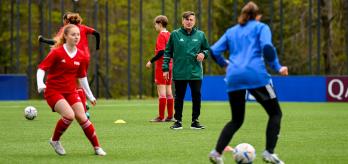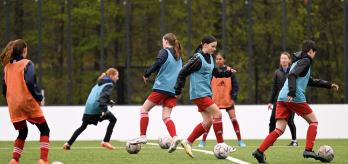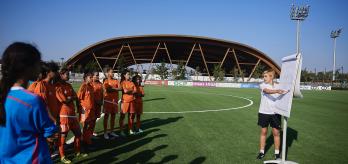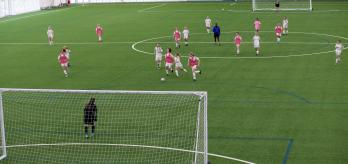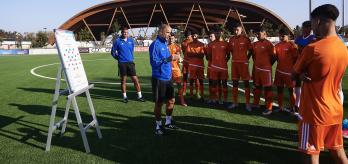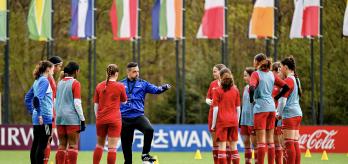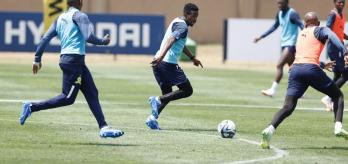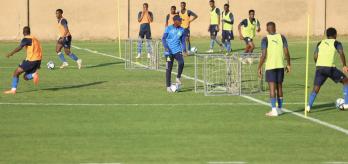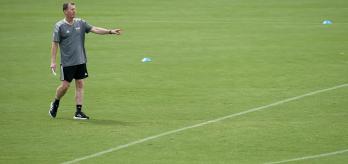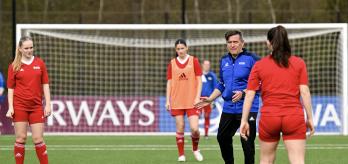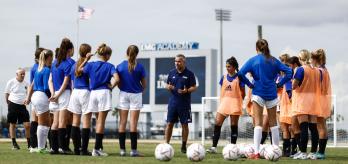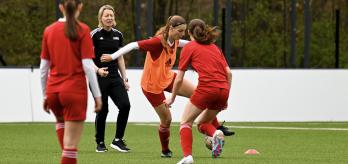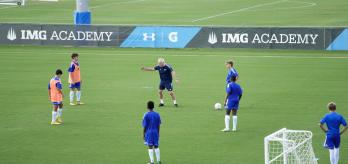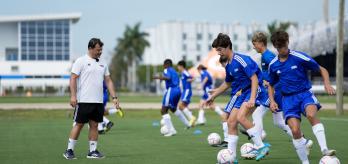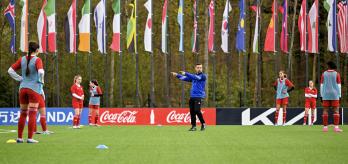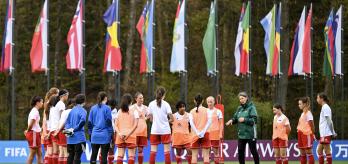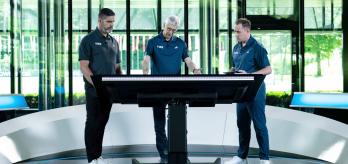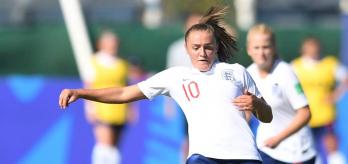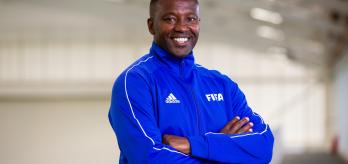However, during the FIFA Training Centre filming, the Sundowns found themselves with seven days to prepare for a cup final, giving them a rare opportunity to have what Mokwena calls a “Matchday +3”. This type of extra training day acts as a bridge between the training cycles of the previous and upcoming games; it is a blessing in terms of injury prevention and provides the opportunity to look ahead to the physical, technical and tactical demands of the upcoming final.
The first part of the session features two circuits consisting of physical exercises that facilitate injury prevention and direct physical development in a way which compliments the Sundowns’ playing style. The second part works on the accurate passing required to allow players to play at pace when under pressure. The session is rounded off with a real-game scenario in which players are tasked with bringing together everything they have worked on during the course of the session.
Session overview
Key points
-
Session designed to vary the volume intensity of all aspects of the session from an emotional, physical and tactical perspective.
-
Primary focus on the weekend’s game but also taking into account the recovery from the last game.
-
All exercises orientated around the team’s way of playing including the injury prevention and stabilisation work to begin the session.
-
Small-sided game to finish the session used to give confidence to the players as well as further instil a number of principles such as playing in tight spaces, playing forward as a priority and transitioning with speed.
Part 1: Stabilisation & injury prevention
The plate and station circuits target explosiveness, endurance and conditioning. The combination of exercises are designed to help prevent injuries during a packed match schedule and to develop physical capabilities in a way which supports what the Sundowns want to achieve on the pitch.
Organisation
-
Arrange the players into pairs and ask them to stand a short distance apart while facing each other.
-
Give one of the pair a plate weight.
Explanation
-
The players perform a number of warm-up exercises.
-
They mirror each other, with one of the pair performing the exercises while carrying the weight and the other performing them without it.
Organisation
-
Split the players into groups of 4.
-
Set up eight exercise stations in a circuit format.
Eight stations
Ask players to perform the following exercises using the following equipment:
-
Sprinting (speed cord)
-
Lateral sprinting (speed cord)
-
Leg curls (resistance band)
-
Kettlebell front squat (kettlebell)
-
Single-leg squat and twist (weight plate)
-
Single-arm, single-leg standing shoulder press (dumb-bell)
-
Step lunge with double-arm dumb-bell raise (exercise step and dumb-bells)
-
Lateral plank with single-arm dumb-bell raise and leg raise (exercise mat and dumb-bell)
Explanation
-
Each group is assigned to an exercise station.
-
The coach sets a time period that each group are to spend at each station.
-
When the coach blows the whistle, the players move in a clockwise direction to the next station.
-
The warm-up is complete once the players have performed all eight exercises.
Part 2: Passing competition
This part of the session focuses on passing. The drill involves a passing sequence that emphasizes precise passing and ball reception. During this drill, players work on their passing accuracy and timing to enhance their overall performance on the field.
-
Split the players into four groups of 6.
-
Mark out four adjacent 10 x 20m exercise areas.
-
Assign one group to each exercise area.
-
Place two mini-goals at one end of each exercise area.
-
Position three mannequins in a triangle in the centre of each exercise area.
-
Place the first mannequin 10m from the mini-goals.
-
Place the other two mannequins 5m behind the first mannequin and 5m apart.
-
Position a cone centrally at the opposite end of the playing area.
-
Line 3 players up between the mini-goals and a position a player at each of the three mannequins.
-
The sequence begins with the player between the two mini-goals (A) in possession.
-
A plays a pass to B, who is positioned at the first mannequin.
-
B makes a short movement to take up a position in front of their mannequin before playing a return pass to A and turning to face C.
-
A plays a pass into C, who advances to a position in front of their mannequin.
-
A follows their pass and moves to the first mannequin.
-
C plays a short lay-off to B.
-
As soon as they have played the lay-off, C darts around the outside of their mannequin.
-
B plays a return pass to C before taking up a position behind the mannequin previously occupied by C.
-
C attempts to score into the mini-goal on their side of the exercise area with a first-time finish.
-
The sequence is repeated on the other side of the exercise area, with A playing the ball into D.
-
The sequence alternates between each side of the exercise area.
-
Players rotate positions by following their pass to the next mannequin.
Increase the difficulty of the exercise by adding new variations and passing combinations. In addition, an element of competition can be added by counting the number of goals scored by each group.
Variation 1
-
Instead of returning the pass to A, B takes up a position behind their mannequin and takes a touch before turning and playing a one-two with either C or D.
Variation 2
-
C and D do not play a return pass to B but instead take a touch to control the ball that takes them around the mannequin before finishing into the mini-goal.
-
Make the correct on- and off-the-ball movement to ensure the fluency of the sequence.
-
Ensure that passes are played into the recipient’s path to enable them to play first-time passes.
-
Adopt an open body orientation so that you face the direction in which you intend to play.
Part 3: Conditioning and pressing drill
This multifaceted drill not only improves conditioning, passing, and pressing skills but also enhances players’ ability to adapt quickly.
-
Split the players into four groups of 6.
-
Mark out four adjacent 10 x 10m zones.
-
Place 4 players from each group inside the zone.
-
Position 2 players from each group inside the working station.
-
Set up a different strength and endurance exercise in each of the four working zones.
-
The 4 players inside the zone pass the ball to each other.
-
The 2 players in the working station perform a conditioning exercise.
-
On the coach’s command, the 2 players in the working station move into their group’s zone, where the press the in-possession players and attempt to win possession of the ball.
-
Once the pressing players regain possession, they switch roles with 2 players from inside the zone.
-
Once all of the players have performed the conditioning exercise, each group moves to the next station, which features a different conditioning exercise.
-
Burpees
-
Hopping over two sets of poles that form an “x” shape
-
Resistance ball wrestling against a team-mate
-
Shoulder barge (lean) into an exercise ball with a team-mate
-
Perform the conditioning exercises at high intensity with a view to carrying the same energy levels into the press.
-
Apply the press immediately upon the coach’s command in an effort to force the in-possession players into mistakes.
Part 4: Explosive preparation
Following the conditioning and pressing drill, the players were asked to perform some straight-line running and sprints. It was important that the players switched on the muscle fibres needed for the next exercises which required more explosive movements.
Part 5: 2v1/3v2 transitions & 1v1 finishing
Part 5 consists of three phases, each of which demands the explosive movement activated in part 4. The exercise fuses together collective transitions and individual finishing in a fast-paced setting.
-
Use a full-size pitch.
-
Mark out a 20 x 40m playing area in the centre of the full-size pitch.
-
Place a full-size goal at either end of the playing area.
-
Position a goalkeeper in each goal.
-
At one end of the pitch, mark out a line on either side of the penalty area between the corner of the playing area and the point where the penalty area meets the byline.
-
Position a full-size goal in between the penalty area and the touchline on each side of the pitch.
-
Position a goalkeeper in each of these goals.
-
Split the group into two teams and position them at opposite ends of the playing area.
-
A coach occupies a position beyond the playing area and has a number of balls.
-
The sequence starts with a 2v1 scenario (blues v. oranges) inside the playing area.
-
When a goal is scored or there is a dead-ball situation, 2 orange players enter the playing area to create a 2v3 scenario.
-
When a goal is scored or there is a dead-ball situation, 1 orange player leaves the playing area and joins their team-mates in the queue behind the goal.
-
The remaining players sprint towards one of the flanks on the full-size pitch to create a 1v1 scenario.
-
As they sprint towards the full-size goal, a coach plays a ball into the area between the two players.
-
The players compete for possession and try to progress play towards the goal and score.
-
In the meantime, another 2v1 scenario is initiated.
-
The sequence is repeated each time a goal is scored or there is a dead-ball situation.
-
React quickly to transitions and display explosiveness to beat the opponent to the ball.
-
Play firm and accurate passes, and play at high intensity to exploit any gaps left by the opposition.
-
Ensure that all movement, both on and off the ball, is performed at high tempo and be prepared for an attacking/defensive transition at all times.
-
Make off-the-ball movement constantly to pull defenders out of position and create space in which to attack.
-
Focus on close control, power, change of direction and feints to beat opponents in the 1v1 scenario.
Part 6: 8v8+8
This exercise, which involves an 8v8+8 game played on a reduced playing area, focuses on bringing all of the aspects worked on in the previous exercises together. Players are asked to perform quick, explosive transitions and play accurate passes.
-
Mark out a 20 x 40m playing area.
-
Place a full-size goal at either end of the playing area.
-
Position a goalkeeper in each goal.
-
Split the group into three teams of 8.
-
Place two teams inside the playing area to contest an 8v8 game.
-
Position the players on the remaining team around the outside of the playing area.
-
Play starts with one of the goalkeepers.
-
The in-possession team try to build up play and score in the opposition’s goal.
-
The in-possession team can use any of the eight outside players to build up an attack.
-
The out-of-possession team try to win the ball back and score in the opposite goal.
-
The outside players can only pass the ball back to the team that played the ball to them.
-
After a goal is scored or the ball goes out of play, the game resumes with one of the two goalkeepers.
-
After one minute of play or on the coach’s command, the outside team rotate with one of the teams inside the playing area.
-
Goalkeepers switch every minute if the session involves more than two goalkeepers.
-
Create overloads by using the outside players at every opportunity.
-
Use an outside player as a third man in passing sequences as an effective tool to progress play.
-
Transition quickly and with urgency after possession is regained, as this is when the opposition are likely to be at their most vulnerable.
-
Manage the players’ workload by deciding which team leave and remain on the playing area. In this instance, the coach ensures that the blue team are given more playing time, as the blue-team players may require a higher workload or a more intensive session than the members of the other two teams.
















